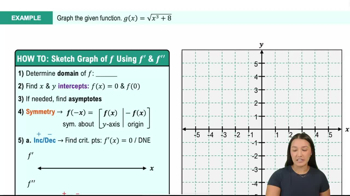Table of contents
- 0. Functions7h 52m
- Introduction to Functions16m
- Piecewise Functions10m
- Properties of Functions9m
- Common Functions1h 8m
- Transformations5m
- Combining Functions27m
- Exponent rules32m
- Exponential Functions28m
- Logarithmic Functions24m
- Properties of Logarithms34m
- Exponential & Logarithmic Equations35m
- Introduction to Trigonometric Functions38m
- Graphs of Trigonometric Functions44m
- Trigonometric Identities47m
- Inverse Trigonometric Functions48m
- 1. Limits and Continuity2h 2m
- 2. Intro to Derivatives1h 33m
- 3. Techniques of Differentiation3h 18m
- 4. Applications of Derivatives2h 38m
- 5. Graphical Applications of Derivatives6h 2m
- 6. Derivatives of Inverse, Exponential, & Logarithmic Functions2h 37m
- 7. Antiderivatives & Indefinite Integrals1h 26m
- 8. Definite Integrals4h 44m
- 9. Graphical Applications of Integrals2h 27m
- 10. Physics Applications of Integrals 2h 22m
5. Graphical Applications of Derivatives
Curve Sketching
Problem 5d
Textbook Question
Use the graphs of ƒ' and ƒ" to complete the following steps. <IMAGE>
Plot a possible graph of f.
 Verified step by step guidance
Verified step by step guidance1
Begin by analyzing the graph of ƒ'. The graph of ƒ' provides information about the slope of the original function ƒ. Where ƒ' is positive, ƒ is increasing, and where ƒ' is negative, ƒ is decreasing.
Identify the critical points on the graph of ƒ'. These are the points where ƒ' = 0 or where ƒ' is undefined. At these points, the graph of ƒ may have local maxima, minima, or points of inflection.
Examine the graph of ƒ". The second derivative, ƒ", gives information about the concavity of ƒ. If ƒ" is positive, the graph of ƒ is concave up, and if ƒ" is negative, the graph of ƒ is concave down.
Use the information from ƒ' and ƒ" to sketch the graph of ƒ. Start by plotting the critical points and inflection points, then draw the curve ensuring it increases or decreases according to ƒ' and is concave up or down according to ƒ".
Finally, refine the sketch by ensuring continuity and smoothness, and check that the behavior of the graph of ƒ aligns with the given graphs of ƒ' and ƒ". Adjust the sketch as necessary to accurately reflect the derivative information.
 Verified video answer for a similar problem:
Verified video answer for a similar problem:This video solution was recommended by our tutors as helpful for the problem above
Video duration:
5mPlay a video:
Was this helpful?
Key Concepts
Here are the essential concepts you must grasp in order to answer the question correctly.
Derivative and Its Graph
The derivative of a function, denoted as f', represents the rate of change of the function at any given point. The graph of f' indicates where the original function f is increasing or decreasing. If f' is positive, f is increasing; if f' is negative, f is decreasing. Understanding the behavior of f' is crucial for sketching the graph of f.
Recommended video:

Graphing The Derivative
Second Derivative and Its Graph
The second derivative, denoted as f'', measures the rate of change of the first derivative. It provides information about the concavity of the function f. If f'' is positive, the graph of f is concave up, indicating a local minimum; if f'' is negative, the graph is concave down, indicating a local maximum. This concept is essential for determining the shape of the graph of f.
Recommended video:

The Second Derivative Test: Finding Local Extrema
Critical Points and Inflection Points
Critical points occur where the first derivative f' is zero or undefined, indicating potential local maxima or minima. Inflection points occur where the second derivative f'' changes sign, indicating a change in concavity. Identifying these points is vital for accurately plotting the graph of f, as they highlight significant features of the function's behavior.
Recommended video:

Critical Points

 11:41m
11:41mWatch next
Master Summary of Curve Sketching with a bite sized video explanation from Callie
Start learning




